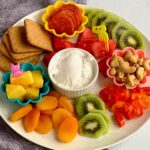Tired of the same old lunch routine? Craving delicious, healthy meals without the soy? This comprehensive guide, “Meal Prep Made Easy: Soy-Free Recipes for the Week,” unveils a vibrant world of flavorful, soy-free dishes designed for busy lifestyles. Imagine a week brimming with satisfying breakfasts, quick lunches, and impressive dinners, all crafted from simple, accessible ingredients. We’ll equip you with essential pantry staples, simple substitutions, and step-by-step recipes, transforming your meal prep from a chore into a creative culinary adventure. Prepare to conquer your week with ease and deliciousness!
From the foundational principles of soy-free meal planning to advanced techniques for maximizing efficiency, this guide provides a complete toolkit. We’ll delve into the nutritional benefits of each recipe, offering a visually rich experience through detailed descriptions of infographics and vibrant imagery within the step-by-step instructions. Get ready to ditch the soy and embrace a week of flavor-packed, satisfying meals.
Soy-Free Meal Prep Basics
Soy-free meal prepping offers a delicious and convenient way to manage various dietary needs and preferences. Eliminating soy from your diet can be beneficial for individuals with soy allergies or intolerances, those following specific elimination diets, or those simply seeking to diversify their nutritional intake. This approach allows for greater control over ingredients and reduces the risk of unexpected reactions while simultaneously promoting healthy eating habits through planned, nutritious meals.
Soy-free meal preparation simplifies healthy eating by providing pre-portioned, ready-to-eat meals, reducing impulsive unhealthy food choices and saving valuable time throughout the week. Careful planning and preparation ensures balanced nutrition, contributing to improved energy levels, better digestion, and overall well-being.
Essential Pantry Staples for Soy-Free Cooking
A well-stocked pantry is the foundation of successful soy-free meal prepping. These five staples provide a versatile base for a wide array of recipes, offering both convenience and nutritional value. Remember to always check labels to ensure products are truly soy-free.
- Extra Virgin Olive Oil: A healthy fat source for cooking and dressing. It adds flavor and richness to dishes without the need for soy-based oils.
- Canned Beans (Chickpeas, Black Beans, Kidney Beans): Excellent sources of protein and fiber, perfect for soups, salads, and as a base for vegetarian meals. They offer a fantastic soy-free alternative to soy-based protein sources like tofu.
- Brown Rice: A whole grain providing complex carbohydrates, fiber, and essential nutrients. It serves as a base for many meals and can be used in bowls, stir-fries, and as a side dish.
- Quinoa: Another excellent whole grain, quinoa is a complete protein, offering all nine essential amino acids. It can be used in place of rice, as a salad ingredient, or in grain bowls.
- Coconut Aminos: A soy-free alternative to soy sauce, offering a similar salty, umami flavor. It can be used as a marinade, in stir-fries, or as a condiment.
Weekly Soy-Free Meal Plan
This meal plan offers a balanced selection of soy-free recipes, emphasizing variety and nutritional completeness. Each recipe is designed to be easily prepared in advance and stored for convenient consumption throughout the week.
| Recipe Name | Day | Ingredients | Summary |
|---|---|---|---|
| Lentil Soup | Monday | Red lentils, carrots, celery, onion, vegetable broth, spices | Hearty and flavorful soup, packed with protein and fiber. |
| Chicken and Quinoa Salad | Tuesday | Cooked chicken breast, quinoa, cucumber, tomatoes, red onion, lemon vinaigrette | Light and refreshing salad, high in protein and healthy fats. |
| Black Bean Burgers | Wednesday | Black beans, oats, onion, garlic, spices, breadcrumbs (ensure soy-free) | Delicious and satisfying vegetarian burgers, perfect for a quick and easy meal. |
| Sheet Pan Roasted Vegetables with Salmon | Thursday | Salmon fillets, broccoli, bell peppers, zucchini, olive oil, herbs | Easy and healthy sheet pan meal, rich in omega-3 fatty acids and vitamins. |
| Chickpea Curry | Friday | Chickpeas, coconut milk, onion, garlic, ginger, curry powder, spinach | Creamy and flavorful curry, a great source of plant-based protein. |
Soy-Free Breakfast & Snack Options

Starting your day and fueling your body throughout the day with delicious and nutritious soy-free options is easier than you think. These recipes are designed to be quick, convenient, and packed with protein to keep you feeling full and energized, all while avoiding soy. The following recipes offer vibrant flavors and textures, making healthy eating a delightful experience.
Quick & High-Protein Soy-Free Breakfasts
These two breakfast recipes are designed for busy mornings, delivering a substantial protein boost to kickstart your day without relying on soy products. Both are easily adaptable to your preferred tastes and dietary needs.
- Savory Quinoa Breakfast Bowl: This hearty bowl combines fluffy quinoa with a medley of colorful vegetables and a sprinkle of nutritional yeast for a cheesy flavor. Prepare the quinoa the night before for an even quicker morning. Ingredients include cooked quinoa, sautéed spinach and bell peppers (red and yellow for visual appeal), a poached egg (the yolk adds richness and creaminess), and a generous dusting of nutritional yeast. The vibrant greens and yellows contrast beautifully with the creamy yellow of the egg yolk. The preparation involves simply combining the pre-cooked quinoa with the sautéed vegetables and topping with the poached egg and nutritional yeast.
- Coconut Flour Pancakes with Berries: These fluffy pancakes are naturally soy-free and offer a delightful sweetness. The light golden-brown pancakes, speckled with the darker hues of berries, create a visually appealing breakfast. Ingredients include coconut flour, eggs, unsweetened almond milk, a touch of maple syrup for sweetness, and a mix of fresh or frozen berries (such as blueberries, raspberries, and strawberries). The preparation involves whisking together the dry and wet ingredients, cooking small portions on a lightly oiled griddle until golden brown, and topping with a vibrant scattering of berries.
Portable Soy-Free Snacks
These three snacks are designed for easy transport and consumption, providing a healthy and satisfying boost of energy throughout your day. They are perfect for packing in lunchboxes or carrying in a bag for a quick and convenient snack on the go.
- Hard-Boiled Eggs with Everything Bagel Seasoning: Hard-boiled eggs are a classic protein-packed snack. The pearly white of the egg contrasts beautifully with the dark specks of everything bagel seasoning. The preparation involves boiling eggs until hard, peeling them, and generously sprinkling them with everything bagel seasoning for a savory kick. The combination of the creamy egg white and yolk with the crunchy seasoning offers a delightful textural contrast.
- Trail Mix with Seeds and Nuts: A customized trail mix offers a blend of textures and flavors. The mix of various seeds and nuts creates a visually interesting snack with diverse colors and shapes. Ingredients include pumpkin seeds (light green and slightly flattened), sunflower seeds (darker and oval-shaped), almonds (pale beige and oval), walnuts (dark brown and irregular), and unsweetened coconut flakes (white and shredded). The preparation involves simply combining the chosen ingredients in a bowl or container. The contrast in shapes and colors makes it visually appealing.
- Apple Slices with Almond Butter: A simple yet satisfying snack, apple slices paired with almond butter provide both sweetness and healthy fats. The crisp, bright red of a sliced apple contrasts beautifully with the creamy beige of the almond butter. The preparation involves simply slicing an apple (such as a Fuji or Gala apple for their sweetness and crispness) and spreading almond butter on the slices. The contrast between the crunchy apple and smooth almond butter is both visually and texturally pleasing.
Advanced Soy-Free Meal Prep Techniques
Mastering soy-free meal prep involves more than just finding suitable recipes; it’s about optimizing your workflow for efficiency and minimizing time commitment while maintaining food quality. This section delves into advanced strategies to elevate your soy-free meal preparation game.
Efficient soy-free meal preparation hinges on strategic planning and execution. Overcoming common challenges and implementing proper food storage are key to success. By streamlining your process and understanding the nuances of soy-free ingredients, you can create delicious and nutritious meals throughout the week with minimal effort.
Maximizing Efficiency in Soy-Free Meal Prep
Efficient soy-free meal prep relies on a multi-pronged approach. First, meticulous planning is paramount. Create a weekly menu incorporating similar cooking methods or ingredients to reduce prep time. For example, roasting a large batch of vegetables on Sunday can be used in multiple meals throughout the week. Secondly, utilize time-saving techniques like batch cooking grains, chopping vegetables in advance, and prepping protein sources ahead of time. Consider investing in tools like a food processor or slow cooker to expedite certain tasks. Finally, dedicate a specific time slot for meal prep, treating it like any other important appointment. This prevents meal prep from becoming a last-minute scramble. Imagine a Sunday afternoon dedicated solely to preparing your meals, transforming chaotic cooking into a calm, efficient process.
Addressing Common Challenges in Soy-Free Meal Prep
Soy-free cooking presents unique challenges. Finding suitable soy-free alternatives for common soy-based ingredients like soy sauce, tofu, and textured vegetable protein requires research and experimentation. Many soy-free alternatives can be more expensive than their soy-containing counterparts. A common hurdle is the potential for cross-contamination if you are not careful. To overcome these, create a dedicated soy-free area in your kitchen, thoroughly clean utensils and surfaces after using them, and meticulously check ingredient labels. Embrace creativity and experimentation. Explore diverse cuisines and ingredients to discover new flavor profiles and textures. For example, instead of soy sauce, explore coconut aminos or tamari (ensure it’s soy-free!). Planning your meals around less expensive, readily available soy-free staples can also help manage costs.
Soy-Free Food Storage and Preservation
Proper food storage is critical for maintaining the freshness and quality of soy-free meals. Understanding the optimal storage conditions for various ingredients is crucial. For instance, leafy greens should be stored in airtight containers lined with paper towels to absorb excess moisture, preventing wilting. Cooked grains and proteins should be stored in airtight containers in the refrigerator for up to 3-4 days. Freezing is a valuable tool for extending the shelf life of prepared meals and ingredients. Portion your meals into freezer-safe containers for easy grab-and-go options throughout the week. Proper labeling with dates is essential for efficient inventory management and prevents food waste. Imagine a freezer organized with clearly labeled containers of perfectly portioned meals, ready for a quick and healthy lunch or dinner. This organized approach eliminates decision fatigue and ensures consistent access to delicious, nutritious food.
Embarking on a soy-free meal prep journey doesn’t have to be daunting. With the right strategies and delicious recipes, it can be a transformative experience. This guide provides not only a week’s worth of satisfying meals but also a foundation for building your own soy-free culinary repertoire. By mastering the techniques and understanding the nutritional benefits of each dish, you’ll be empowered to create a healthy and enjoyable eating experience, week after week. So, ditch the takeout and embrace the joy of creating delicious, healthy, and soy-free meals that fuel your body and satisfy your soul.
Helpful Answers
What are some common soy substitutes?
Common soy substitutes include tofu alternatives like tempeh or seitan, nutritional yeast for a cheesy flavor, and sunflower seeds or tahini for creamy textures.
How long can I store my prepared soy-free meals?
Properly stored soy-free meals can last 3-5 days in the refrigerator. Always ensure food is properly cooled before refrigeration.
Can I adapt these recipes to different dietary needs (e.g., vegan, vegetarian)?
Many of these recipes are easily adaptable. Check individual recipes for specific dietary modifications and substitutions.
What if I don’t have all the ingredients listed in a recipe?
Substitutions are often possible! Look for similar ingredients with comparable textures and flavors. Many recipes offer suggestions for substitutions.


